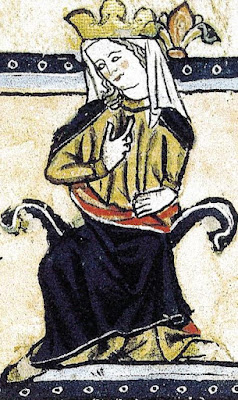 |
| Lords of all we survey at the top of Allariz All photos in this post 2018 Jessica Knauss unless otherwise specified. |
Of course he had a wife—he was the king and needed legitimate heirs. But while Alfonso X, one of the obsessions of my life, is known to everyone in modern Spain, you don't hear much about his bride, Violante.
While I was studying for my PhD, I heard of a famous scholar of Spanish history who thought of writing Violante's biography. He soon learned why none exists: there just isn't enough information about her to fill a book.
 |
| "The Castle," a rocky outcrop at the top of Allariz |
The lack of information about Violante in a court where it seemed everything was written down, and the existence of two or three bastard-providing lovers of the king, have led some scholars to believe that the marriage was not happy. However, Violante and Alfonso had eleven children together, a number that seems above and beyond strict duty.
 |
| Violante in a thirteenth-century manuscript, Tumbo de Touxos Outos. Another presumed portrait, from the Libro de ajedrez, is in this blog's banner. Wikimedia Commons |
I knew only two other facts about Queen Violante.
One, during the emotionally taxing confusion over who should inherit the kingdom when Alfonso's and Violante's firstborn son was killed in battle in 1275, the queen fled back to Aragón with her two young grandchildren, who stood to gain under Alfonso X's new laws. She eventually returned to court and must've made some kind of peace with her husband and second son, although nothing much more is said about her.
 |
| Typical Galician grain storage at the entrance to Allariz |
I imagined Violante living out her days in the rainy gray weather of Celtic Galicia. For my birthday this year, I wanted to see the place where my fellow widow lived in constant sorrow after the love of her life left her all alone in the world.
 |
| Allariz's Praza Maior features the Romanesque Church of Santiago, which Violante probably visited. |
I imagined Violante felt lonely even surrounded by a royal retinue when coming to settle in this green land. Although I was taking taxis, city buses, and intercity buses just as alone, I did it with a sense of accomplishment I could never have achieved from my shotgun position in a friend's car. Those bus rides were, in a way, the culmination of all my years of studying the Spanish language and the history of Spain.
 |
| The Galician flag blends in with the Galician sky at the top of Allariz |
I felt like a queen at the top of that rock, looking down at valleys, so many green trees, and roads and houses. Would this have been enough after thirty-two years as the queen of an entire dynamic country? I inhaled the clear air, cool the way August mornings can be with their powerful gusts, and thought that yes, it could be plenty. I recognized the influence of my departed husband in that assessment, and wondered if Violante would ever have agreed.
 |
| Convent of Santa Clara, Allariz |
Violante founded the convent in 1286 with her son, King Sancho IV, and decided to be buried here, but precisely because it was a royal convent, it had plenty of money to do complete overhauls with changing architectural tastes, and almost nothing of the original convent survives. A fire in the eighteenth century obliterated most of what would've been recognizably Gothic. This convent has the largest cloister in Galicia, but no visits are allowed.
 |
| Santa Clara with the Church of San Benito |
The Virgen Abridera (opening Virgin) was made in the thirteenth century from a single elephant tusk (not okay to do today—don't even think about it), at the behest of Queen Violante. When closed, it looks like a finely carved ivory of a Virgin and Child in the cheerful Gothic style of the thirteenth century.
The fine details, the remains of medieval paint, and the craftsmanship in the hingework display the highest quality and remind me of my favorite Gothic art, the illustrations of the Cantigas de Santa Maria.
The back of the sculpture shows how Mary's body adjusts to the curve of the tusk out of which she was carved.
This closeup of the right side shows its 3-D, wedge shape.
This sculpture had incredible presence. It told all its stories with joy and loving care. Through the ages, anyone who really looked at this ivory has probably been moved in a positive way. In the absence of many facts about Violante's life, I got a visceral feeling for her personality by appreciating one of her possessions.
The opening Virgin also seemed to me an apt metaphor for where I am with widowhood: It rips you open. What you find inside determines the quality of the rest of your life.
 |
| Neoclassical fountain in the convent plaza, Allariz |
Good for her. Not shutting herself away, but going where she wanted and living in a way that brought her happiness? That's a widowhood example to follow.








No comments:
Post a Comment